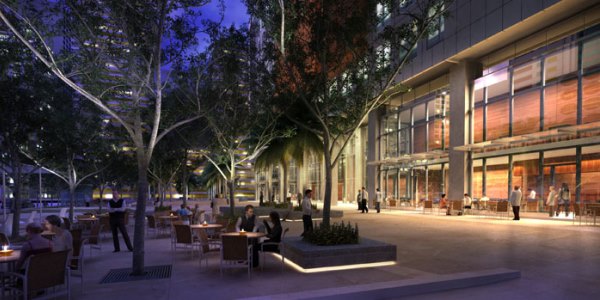
The office market has gained strength throughout Miami-Dade County and the outlook is bright based on good employment growth, limited new construction, scarcity of premium space and new-to-market tenants.
Office vacancy fell to 16.1% in the first three months of 2014 from 16.5% in the fourth quarter of 2013, with an average asking lease rate of $30.72 per square foot in the first quarter, up 29 cents quarter over quarter, with highest asking prices in the Central Business District, said Quinn Eddins, director of research and analysis at CBRE.
“Asking rates reached $60 per square foot for Class A sublet space at the Southeast Financial Center in downtown Miami,” he said. “We’re very bullish on office rents and vacancies poised to decline a couple of percentage points over the next few years before stabilizing in about 2015-2016.”
Miami’s Class A segment has posted a relatively steady reduction in vacancy since midyear 2010, declining from over 22% to the current direct rate of 16.6%, said Brady Titcomb, vice president at JLL.
“Leasing activity in general continues to be captured by Class A buildings, where two-thirds of the city’s total transactions have occurred” in the past 15 months, he said.
 The market continues to improve, with rents rising and vacancy falling, except in Class B buildings in Brickell (fluctuating in the 17% to 18% vacancy range), said Noël Steinfeld, senior vice president of JLL’s capital markets group.
The market continues to improve, with rents rising and vacancy falling, except in Class B buildings in Brickell (fluctuating in the 17% to 18% vacancy range), said Noël Steinfeld, senior vice president of JLL’s capital markets group.
The vacancy rate for Class B buildings in Brickell might be artificial, possibly due to construction inconvenience in that area and landlords aiming at short-term leases because they plan to tear down buildings, she said.
Generally speaking, Miami-Dade has a strong office market, particularly in the Central Business District, since 600 Brickell is just 65% leased, Ms. Steinfeld said.
“We have our own, unique dynamics and have been able to recover for a number of reasons, including the flight of capital out of Latin America, so many projects being built with 50% cash down and the increased demand as it relates to dredging of the port,” she said. “A gradual improvement shows a healthy market.”
Ms. Steinfeld said new construction is low for the anticipated demand, with 128,850 square feet of new space expected to open in the Central Business District in 2015 and Brickell City Centre not due to be finished until 2018.
“Land prices have gone up to as much as 100%,” she said. “The market will get very tight and rents will go up because of demand.”
The Miami office market has bounced back well and is as strong as Washington, DC, Chicago and northern New Jersey, with only San Francisco, Seattle and New York City ahead of it, said Bill Bailey, senior vice president of The Allen Morris Company.
“In a stronger market, people are more confident to renovate, and we are seeing some buildings such as the SunTrust International Center undergoing major renovations,” he said.
Mr. Bailey said vacancy in Miami-Dade is down for all office types and the market in nowhere near peaking, but will keep getting stronger.
As for new construction, Mr. Bailey predicts more soon.
“People will start projects at the end of the year in select areas such as Kendall, South Miami and Brickell where additional office space is needed.”
Market demand drivers are coming together at the same time in an intricate and positive way that herald the arrival of Miami as a true global destination, said Ken Krasnow, South Florida managing director for CBRE. He said all the sectors – including residential, hospitality and retail – are healthy, and the improving office market is just one part of the equation.
“There’s good employment growth – Miami’s job growth market is the third highest in the country – and we’re continuing to see strong signs of net migration moving into the market, both national and international, with projections over the next five years to have the highest, just behind Dallas,” Mr. Krasnow said. “We’re still growing and undergoing a cultural renaissance, with increasing art, high-end retail and new restaurants.”
Those factors, coupled with the excellent weather and favorable tax conditions that were always representative of life in Miami, have been magnified over the past few years, he said.
“We’re expecting to see a decline in office vacancy rates over the next few quarters and even the next few years.”
Mr. Krasnow said the Class B office market has stabilized and grown, but the most impressive drop in vacancy is in Class A buildings.
“There’s been a strong flight to quality [office buildings] and substantial gains in submarkets and core properties” that include parts of Doral, Airport West, downtown, Brickell and Coral Gables,” he said.
Down the road, Mr. Krasnow said, Miami will get new office construction because the market will demand more office space. That new development is currently in the vision, rather than planning, stage, but he said he bases his forecast on an unlimited supply of capital chasing a limited number of products.
“Some brokers have been in preliminary conversations with developers who might have suitable sites and are thinking ahead,” he said. “We’re likely years away from realistic announcements on plans.”
Source: Miami Today







